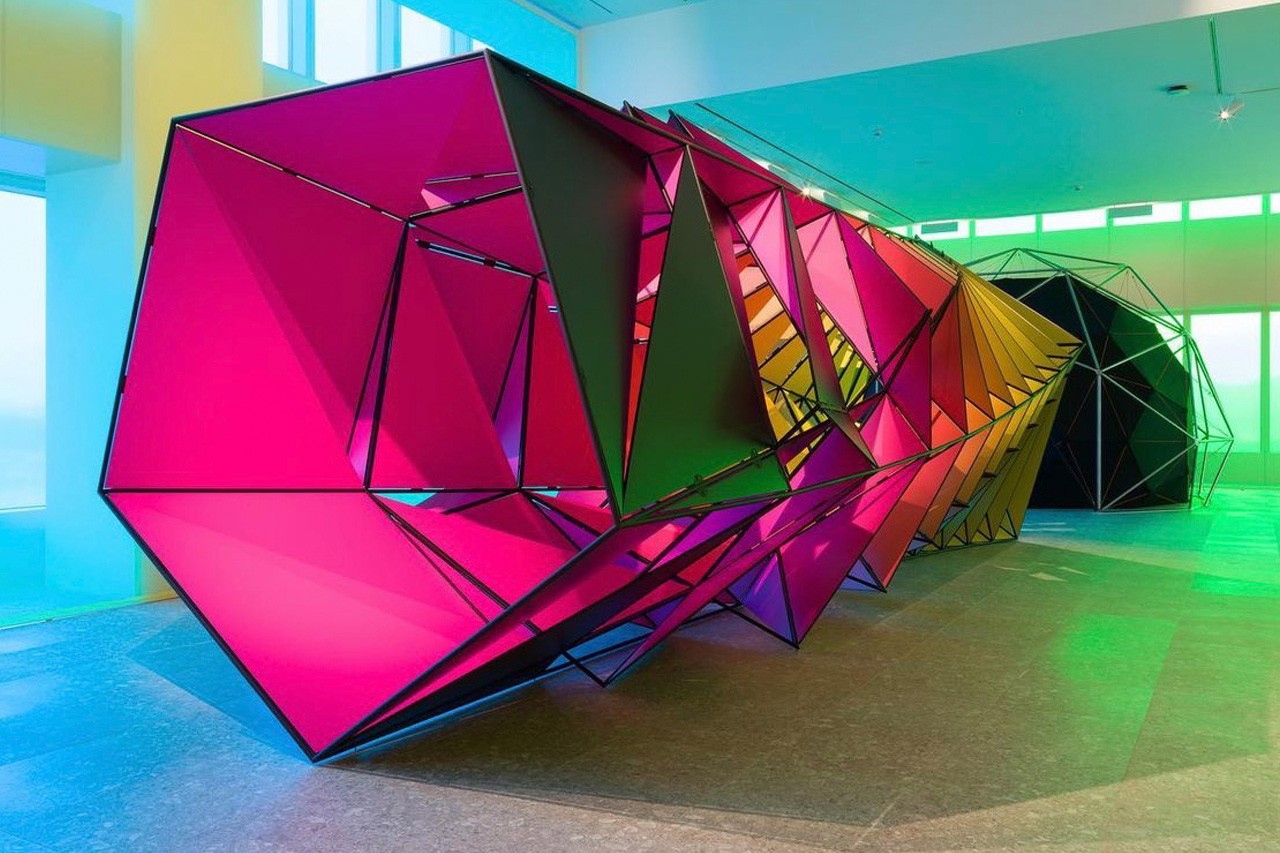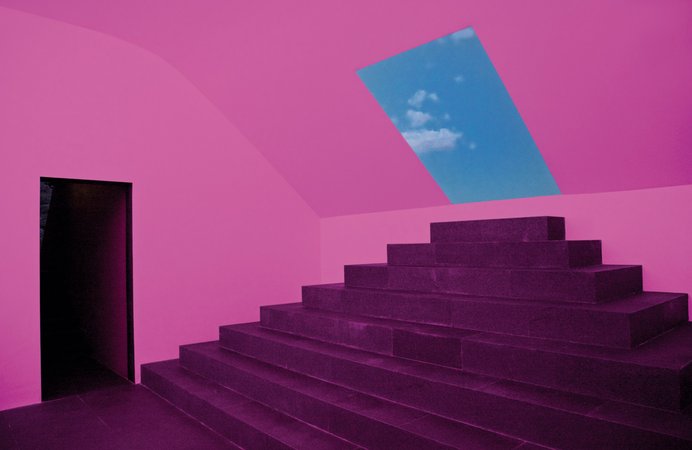

Arousing & Expressing Emotions in Works of Light Art
We cannot easily account for the power of light installation works by borrowing from color science, in the way I tried to sketch above for Rothko. First, these artists employ light rather than pigment. And, second, the colours in the installations tend to shift-there is no single pair or defined combination of colours at work, as in a Rothko canvas. Perhaps some implications from research studies of people’s preferences of color combinations might still be relevant. But there are alternative sources to draw on. Research has been conducted in a variety of fields, ranging from biology and psychology to ergonomics and architecture, concerning the effects of light on human bodies, moods, memory, and performance.
The colours of light (including both brightness and wave length) affect our bodies, brains, and emotions in many ways, altering heart rate, blood pressure, melatonin levels, sleep cycles, and circadian rhythms (Stone 1999). This research has filtered out into the media of popular science and psychology. In northern climates, people know about the role of full spectrum lights in combating so-called SAD (seasonal affective disorder; Kuller et al. 2007). There is much accumulated expertise about the role of types and colours of light in helping to define space, shape mood, and elicit varied viewer reactions.
This scientific research helps explain some aspects of the emotional force of works by Eliasson and Turrell. One way they move viewers is just be- cause the light in the works affects people directly. This is what Robinson in Deeper than Reason calls arousing emotions. She describes how this differs from, but can be related to, expressing emotions by using examples from music. Music can stir us psychologically: it can calm or excite us, make us feel happy or melancholy. Such experience involves numerous physiological changes (Robinson 2005, 406-407). All this is similar to how the light of installation artists’ works can affect people. Coloured environments (especially red and blue ones) affect us physically, altering alertness, brain activity, blood pressure, respiration rates, and more (Hardin 1988, 166-167; Elliot and Maier 2014). In addition, Turrell uses his extensive knowledge of perceptual psychology to construct works that affect our vision directly. The colour shifts in Aten Reign, for example, trigger automatic switches between photopic and scotopic vision (between use of cones and rods in our eyes; Ferro 2013). Eliasson’s Your Blind Passenger disorients people within a world that restricts visual identification of distances and objects.
Robinson says that when moved by music, we may consider why and thus be prompted to interpret specific aspects of the music as expressive. In doing this, I might, for example, say that a song uses a minor key, slow tempo, and wailing voice to express melancholy, perhaps arousing in me a distinct emotion like nostalgia (Robinson 2005, 368-369). Light installation works may not be expressive as some music is, by conveying experiences of a persona, in the way I argued Rothko’s paintings do. But, just as expressive music employs formal musical features of a song or sonata, light art installations employ specific formal features such as location, tempo, arrangement, prescribed forms of behavior, and so on. Like music, these are temporal artworks.
Environmental installations typically slow people down. They require attention and lingering to grasp meaning. Often these works create environments pointing to or recalling experiences of nature. People may find the experience provokes memories of a golden summer day, rainbows, the Northern lights, or a romantic twilit evening. Our responses involve recognition of distinct features we attend to. Similarly, in discussing our encounters with nature, Noel Carroll has argued that emotions are normal responses, which are not altogether subjective because they presuppose recognition of specific features of the environment (1993, 257-260). His view of emotions is similar to Robinson’s treatment of them as types of appraisals that connect bodily responses to evaluations of a situation or action (Robinson 2005, 57-99). Specific objective elements of a waterfall, for example, such as its size, noise, and power, are sources of our awe and wonder. We can have similarly distinctive responses to aspects of a light installation, but, here, we are recognising features of the world that have been deliberately designed for expressive purposes.
As I noted earlier, Robinson argues that art can be expressive by presenting the world as seen by someone in a particular emotion or showing what it is like for a person to see the world that way. Simplifying, an artwork provides expressive insight into how the world looks or how a person feels when viewing such a world. A nice example Robinson gives is Edvard Munch’s famous pain ing The Scream. Here we see both a character in anguish and that this character’s world is bizarre and twisted; it is a world, as Robinson puts it, “infected with the screamer’s anguish and anxiety” (2005, 283).
Artworks like Your Blind Passenger or Aten Reign are like the Munch painting: they show the world as experienced in a certain way: as challenging and disorienting or as mysterious and awe in- spiring. The very fact that colored light affects our perceptual awareness can stimulate conscious reflection about the nature of perception and about how we tend to experience art and museums.36 Just as we can reflect on a musical work that arouses us, perhaps judging it to be expressive of melancholy, so too can we conclude that art installation is expressive of warmth and community, of human in- significance within the vast scope of nature, of the so-called light inside, and so on. Arousal of emotion contributes to but is not identical with recognition of the installation artist’s expressive aims.
Context is an important contributing factor (Robinson 2005, 249). The colored lights of Turrell and Eliasson’s works are set within distinctive created environments. To experience these spaces, they must be sought out; they are wholes separated from everyday life. In Turrell’s skyspaces people must wait for the aperture to be opened; in Eliasson’s Your Blind Passenger they must enter and walk through a tunnel. There is something ceremonial or ritualistic about such a venture, which takes on the nature of a pilgrimage. This is intensified if the work is in a Quaker meeting house or has become as popular as The Weather Project. The Weather Project recalled some ancient religion of sun worship, fostering community even within the vast unfriendly space of the Turbine Hall at the Tate Modern. In Turrell’s works people look up at the vault of the sky, again as in some prehistoric ritual, as if seek- ing the meaning behind falling stars, eclipses, or other “celestial events.
Art installations by Turrell and Eliasson some- times challenge our confidence about seeing and knowing the world. An art installation that pre- vents our ability to see space or judge distances accurately appears to thwart our very nature. We are, after all, visual creatures as the result of a lengthy and complex evolutionary process that gave certain advantages to animals that could see and hence move more efficiently around in their environment to find mates and food and avoid predators. Nevertheless, artworks that make us ponder the nature of physical reality and of how we manage to perceive it, like Eliasson’s and Turrell’s, are valuable in themselves. Color in these artists’ works becomes something very intriguing, mysterious, beautiful, and valuable. It arouses emotions, fulfils expressive functions, and stimulates reflection about reality and ourselves. It does all this so well that I now feel better about endorsing Goodman’s claim that I quoted earlier-about how experiences of abstract work carry over when we leave the gallery or museum into the outside world by making us look at and reflect upon things very differently. Surely this is one of the best things art can do.
CYNTHIA A. FREELAND 2017